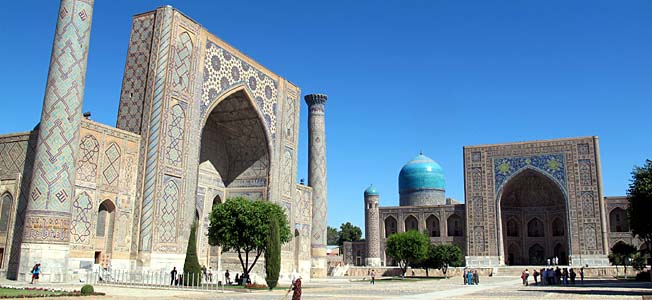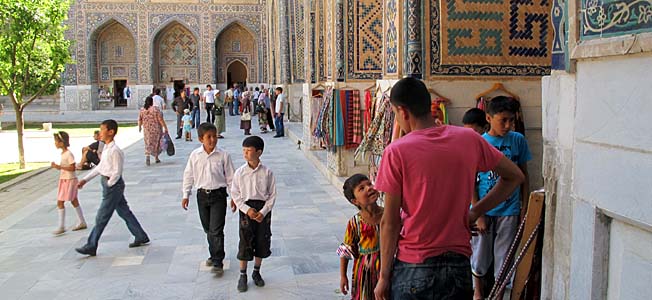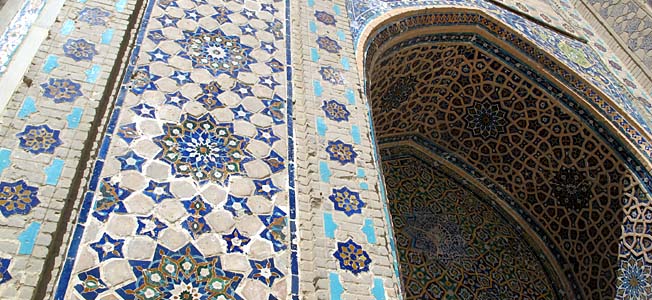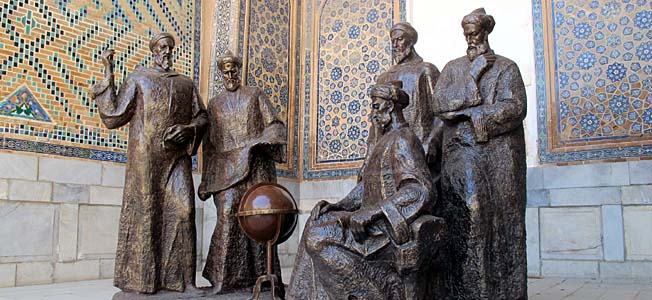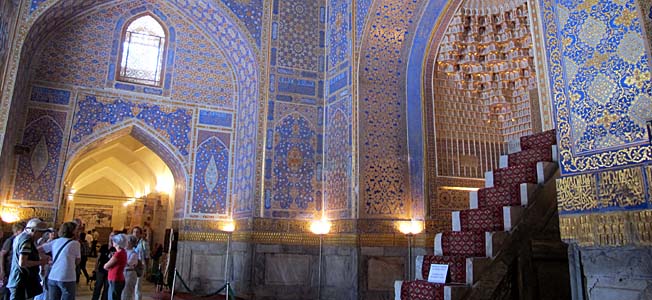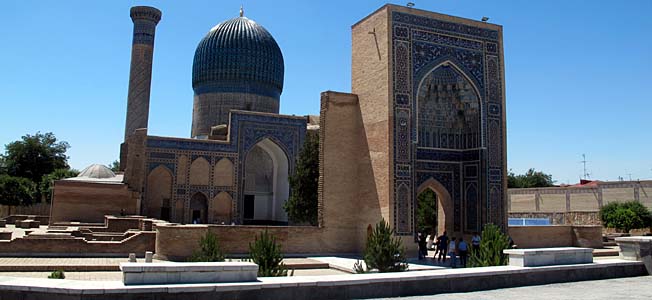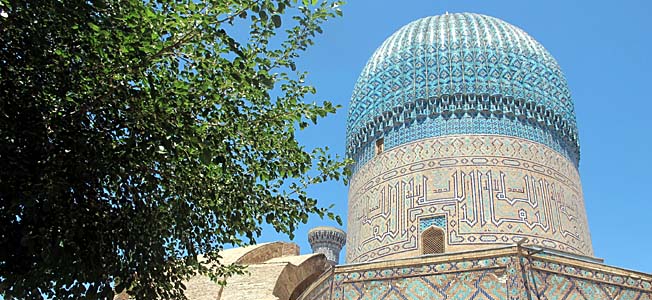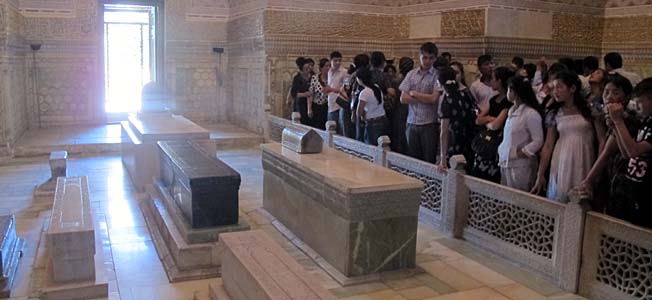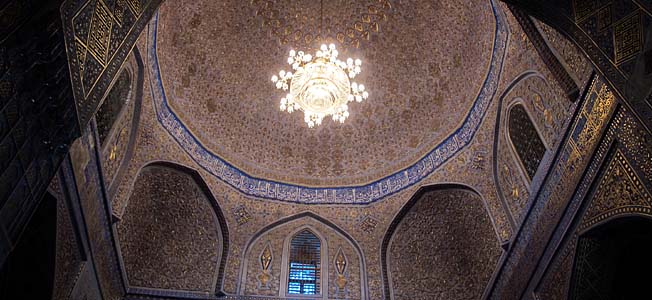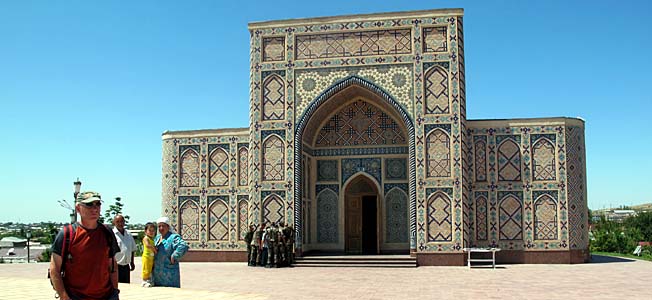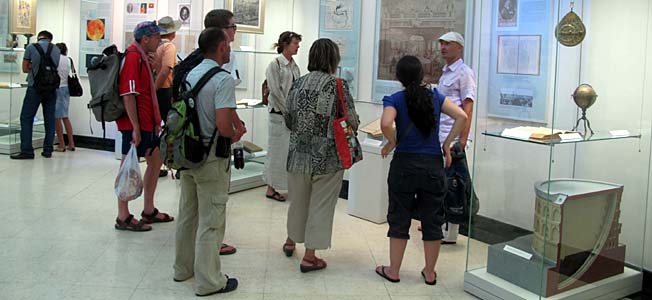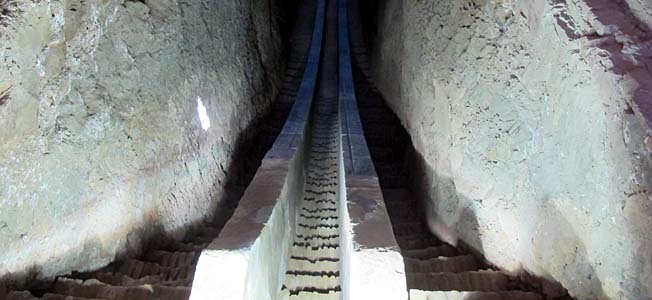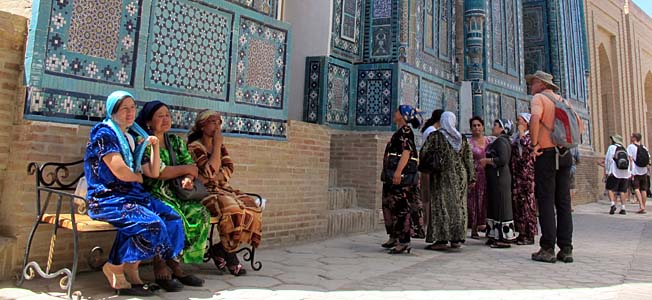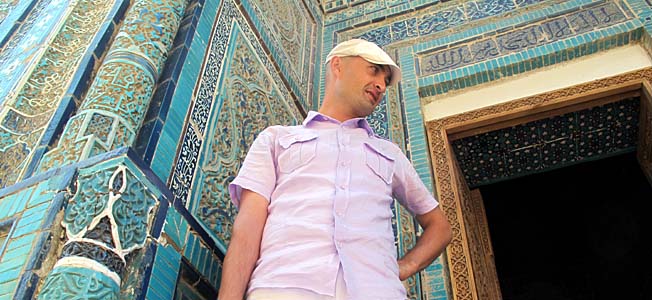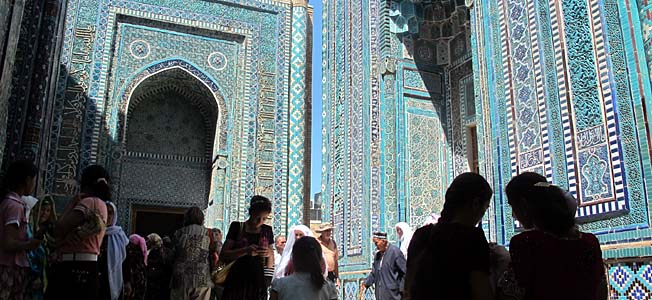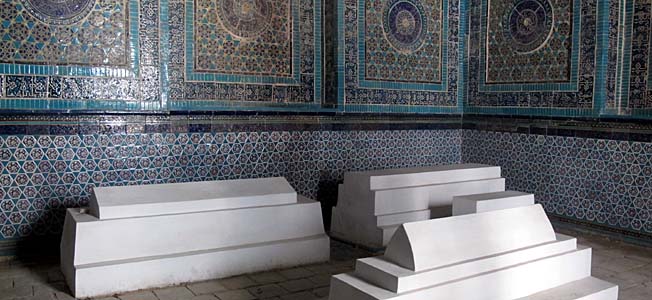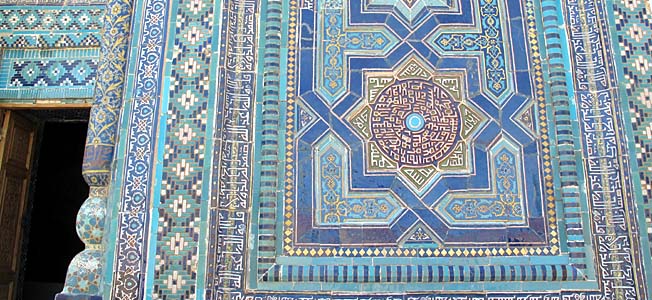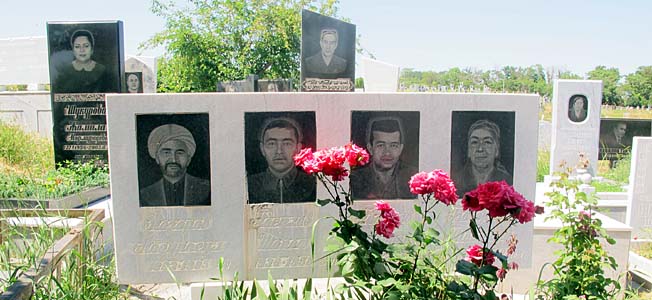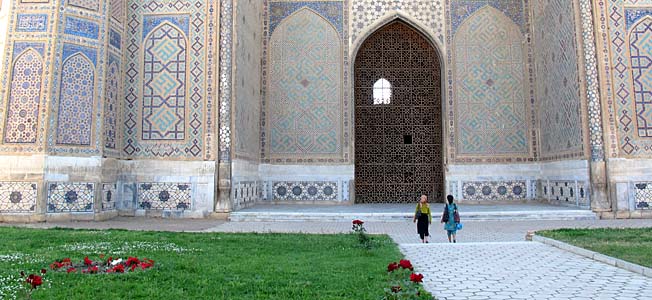Samarkand City Tour and Re-joining of Sam & Archie
Breakfast was at the roof terrace of the hotel. Usually roof terraces are scenic spots but this one wasn’t. The hotel staff used the terrace as workshop for carving doors so I first thought I’m in the wrong spot. Then I spotted a table behind the doors, on which a craftsman was working, where my breakfast was waiting for me. It wasn’t very delicious and consisted of a bread-roll filled with plum marmalade, a hard-boiled egg, a chocolate bar, nuts and dried fruit.
At 9am our local guide Jelol took us on a tour of Samarkand. In the 14th century this city was the capital of the sultanate of Timur. Samarkand is centrally located on the Silk Road and can be seen as crossroad between East and West mixing different cultures and traditions. This mix can still be felt today which make the city an interesting place to visit from a cultural and historical point of view.
It was only a 5-10 min walk from our hotel to the first attraction the Registan Square which felt like the center of the city. On the way we crossed a park with two large golden tiger statues. They were erected because the president of Uzbekistan was born in the year of the tiger or so. It feels really strange to experience how a living being such as the current president is creating monuments for himself so people can admire him.
The Registan Square was very impressive to see. It’s surrounded by a group of beautiful madrasahs. They were built with the intension to make Samarkand the most beautiful city in the world. Therefore, also small villages in the surrounding area of Samarkand where named after large cities such as Madrid, Paris or Damaskus to show Samarkand is more shinier than those “villages”. It took us two hours to walk around the Registan Square. The madrasahs used to be a center of higher education for male Muslims to prepare them for their tasks as imam. In one of the madrasahs we could find a statue of the teachers which was interesting to see since nowadays you won’t find a statue of your professors at your local university.
In one of the madrasahs of the Registan Square there was also a small interesting museum showing the condition in which the Registan Square and other major buildings used to be at the beginning of the last century. Most of these building were damaged by seismic movements. Our guide told us during Soviet times no effort was put into the renovation of Muslim buildings. Only when the Olympics came to the Soviet Union and the government received requests of Western tourists to travel to this part of the country they made cosmetic improvements of inferior quality to the major sights of the city. Nowadays the restoration is done more carefully also involving results of historic research. The restoration of some places appears very time intensive for instance one of the madrasahs contains a very detailed golden mosaic consisting of 4×4 milimeter large mosaic stones.
At the end of our visit of the Registan Square we visited two shops. The first one was a shop were we received a demonstration of local Uzbek instruments. The second one was a clothes shop where they were selling traditional women dresses including a burqa made out of horsehair. Our guide pulled me out of the group and dressed me up in this traditional outfit for demonstration purposes. The burqa completely covered my face so nobody could see it while I was still able to see the people surrounding me. It’s hard to imagine this region used to be very much religious and women needed to cover to the same extend as in Afghanistan. It was also here at Registan Square where women were demonstrating against this dress code and burned their burqas in public.
The second stop of our tour was Timur’s Tomb. Timur, also known as Tamerlane, built this mausoleum but not for himself but for one of his sons who died in a battle. Timur wanted to be as Genghis Khan and since Genghis Khan had four sons Timur also needed to have four sons. I can only imagine what happed to the girls his wife(s) have given birth to. It’s also said the number of his children is actually much higher than four probably because he was quite powerful and they had no contraception at these times. Our guide also told us Timur wasn’t popular at all during Soviet times but once Uzbekistan has reached its independence he’s admired as the great ancient ruler of the nation. When we visited the inside of the mausoleum we were surprised by golden walls and not just one coffin but a number of them. The middle one in black belongs to Timur while the other ones belong to his sons and his spiritual leader. The coffins are pretty small but we learned the bodies aren’t kept in them but one level deeper which is closed to the public.
After a short stop in a tea house we visited the Ulugh Beg Observatory or better to say the place where the observatory used to be since it was destroyed completely. Nowadays you find a museum here explaining how the observatory was functioning and what made it the most accurate observatory of its time. The only part of the observatory which is still there is a part of the large sextant on which the measuring instruments were moved along.
The next stop was the Shah-i-Zinda Mausoleum where family members of Timur are buried. It’s actually not just one big mausoleum as Timur’s one but a series of small mausoleums right next to each other all covered with beautiful mosaics. This spot seemed to be a popular destination for local people since there were many of them visiting the tombs, chilling out next to them or praying in silence. Just behind the mausoleum is a modern graveyard at which I had a quick look at. Compared to the graveyards back home this one had pictures of the dead people engraved on the tombstones which was interesting to see.
The last stop of today’s tour was the Bibi-Khanym Mosque which used to be the largest mosque at its time of construction. Also this mosque was very much destroyed but huge efforts were made to renovate it. The renovation is still ongoing today since no mosaics can be seen inside the mosque and some of the walls still look very much destroyed.
In the evening around 6pm Sam and our truck Archie arrived in Samarkand. We had last seen them on May 11th when our truck broke down in Iran. It took Sam nearly two weeks and more than 7,000 USD to repair the crack in the head of the engine and to catch up with us again crossing two borders. He also had to fight against expiring visas since originally the trip wasn’t planning to stay in Iran and Turkmenistan as long as Sam did due to the breakdown of the truck. During his time in Turkmenistan he more or less needed to drive the whole time since his visa was about to expire. Luckily he made it all the way but unluckily he forgot his passport in the hotel in Bukhara where he has spent last night. However, he will not need to drive back but tomorrow somebody will deliver the passport to him.
In the evening some people went out for dinner to an international restaurant but I heard it wasn’t good. The service was very slow, the food not very tasty and in the end the payment of the bill was 16,000 Sum (6.40 USD) short which is about the amount of a complete dinner for one person. It somehow happens on this leg of the trip that all our payments are short since people don’t put in enough money when paying for whatever they had. Probably it’s because of one or multiple of these reasons: 1) people don’t remember correctly how much their food was, 2) people are unable to add the prices of their foods and drinks and a 15% service charge / tax on top or 3) people try to sneak through on the cost of other people.
Since yesterday was Sam’s birthday we were planning to have a delayed celebration with him tonight. Therefore, a number of people were meeting after dinner in a Blues bar featuring a piano. We picked this spot because Sam is a passionate piano player and he very much enjoyed playing for us while we had a sing-along. While playing Sam also had a number of Vodkas and at one stage he wasn’t able to play anymore and needed to be carried home.


